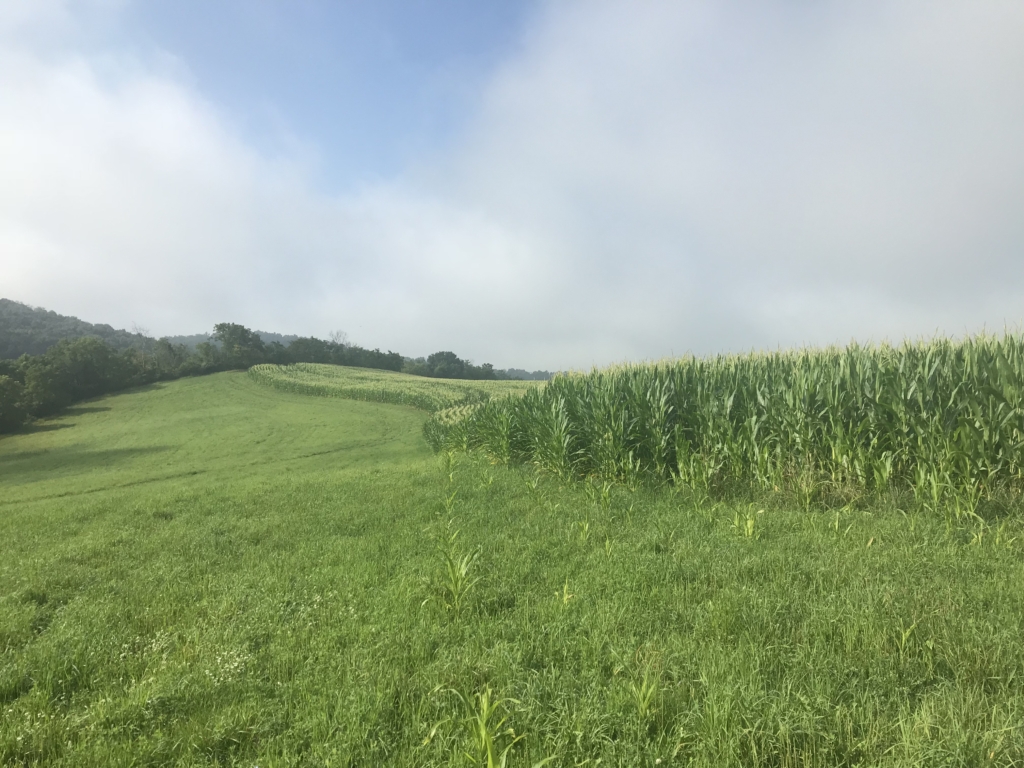Penn State Researchers Find Central Pennsylvania Farmland Resilient to Erosion
Central Pennsylvania farmland may not erode as quickly as expected due to geology and land-use history, according to Penn State researchers.
“Land-use history and the underlying geology go hand-in-hand,” said Perri Silverhart, a master’s student in the Department of Geosciences at Penn State. “The places where people settle and choose to do certain activities are closely tied to the geology. Differences in land use due to geology are important to consider when thinking about how the landscape functions today.”

Silverhart conducting research at Cole Farm. Credit: Julia Carr
The researchers study erosion caused by climate and human processes like agriculture at Cole Farm. Located near the Penn State University Park campus, the site sits on hillslopes that have been continuously farmed for the last 200 years. Current owner and Penn State professor emeritus Herb Cole allows researchers to study it as part of the Susquehanna Shale Hills Critical Zone Observatory. The Shale Hills site is part of a National Science Foundation-funded program with locations across the United States.
Both climate- and human-driven erosion remove soil from hillslopes and deposit it in valleys, but human processes tend to increase erosion rates. The scientists are trying to determine whether erosion at Cole Farm is due largely to climate or human processes.
“We have a good understanding of how humans have impacted the landscapes in southeast Pennsylvania and the Piedmont region,” said Roman DiBiase, assistant professor of geosciences and associate in the Earth and Environmental Systems Institute at Penn State. “We’re trying to understand how humans have impacted the landscape of central Pennsylvania, and in particular the valleys and ridges.”
The results so far seem to suggest that climate has had a larger impact on erosion in the area.
At the end of the last ice age 20,000 years ago, central Pennsylvania resembled the tundra of northern Alaska, said DiBiase. The hillslopes thawed as the climate warmed, and once-frozen soil oozed down into the valleys.
The climate-driven erosion rate in central Pennsylvania ranges from about 20 to 98 feet per million years. Compared to the tectonically active West Coast of the United States, where the erosion rate ranges from 328 to 3,280 feet per million years, or places like the Himalayas and Taiwan, with erosion rates up to 32,800 feet per million years, Pennsylvania’s landscape erodes very slowly, said DiBiase. He attributed the landscape’s resiliency to its geology, which is a mix of shale, limestone and sandstone.

Cole Farm. Credit: Perri Silverhart
European settlers clear cut the hillslopes and began farming the area about 200 years ago. Cole Farm has transitioned from tilling to no-till and cover crop farming methods over the past 30 years. Today, there is approximately 10 feet of deposited material in the valley floor.
The scientists took soil core samples from the farm’s ridges and valley and analyzed them for cesium 137, a fallout radioisotope produced by nuclear reactions and associated with the atomic weapons testing of the 1950s and ‘60s. Its presence in the soil can tell scientists about the rate of sediment movement, deposition and erosion over the last 50 to 60 years.
The cesium profile at the ridgetops, mid-slopes, lower parts of the slopes and the valley floor is about 10 inches deep, according to Silverhart.
“If we were seeing large amounts of recent erosion, the cesium signal would extend well below those 10 inches,” she said.
DiBiase noted that the net erosion rate is likely less than 10 inches over the last five or six decades. He said the cesium profile suggests that there has been mixing of the topsoil and attributed it to past agricultural processes like tilling.
“The combination of the underlying geology and the nature of the land use has led to this landscape being fairly resilient to the influence of agriculture,” he said. “It’s possible that we might have lost part of the soil column when the land was first clear cut and farmed 200 years ago and cannot resolve it with the methods that we’re using. But if you compare this to landscapes in the Midwest where you see intensive gullying due to agriculture over the last 100 years, we don’t see that here.”
Written by Francisco Tutella
